
Wine Culture and Information since 2002 - Volume 22
 Wine Culture and Information since 2002 - Volume 22 |
|
Comparing FranciacortaThe great Italian bubbles are being evaluated this month in our comparative tasting, a journey from Satèn to Brut, passing through Pas Dosé |
|
One of the most striking successes of Italian enology in the last twenty years certainly is Franciacorta. The noble bubbles, produced in the province of Brescia, near the area of Iseo Lake, have quickly conquered the glasses of wine lovers worldwide. The excellent result of Franciacorta has been obtained, first of all, with concrete investments in favor of the culture of quality and, last but not the least, with an excellent job done in communication. Today, when it comes to Italian bubbles, one of the most prestigious names certainly is Franciacorta. These prestigious bubbles are produced with the classic method, adapted and revised for the production of this excellent wine and called Franciacorta method. One of the most interesting characteristics of this method is the period of refermentation in bottle and the subsequent period of aging on the lees: 18 months. The production disciplinary of Franciacorta is in fact very strict and it certainly is among the most exacting ones in terms of quality in the scenery of bubbles and not only in Italy. It certainly is not by chance if, in occasion of international wine contests, Franciacorta wines are always awarded with prestigious results and are considered of higher quality than the other bubbles produced in other countries of the world, including Champagne. The success of Franciacorta is pretty “young” - the first bubbles were produced at the beginning of 1960s - and it will be around the end of 1970s in Franciacorta will be started a process which will have in quality one of the primary goals. The results obtained in Franciacorta are the proof of how important results can be achieved when quality is a goal also supported by facts, an example many should follow.
|
|
Chardonnay, Pinot Noir and Pinot Blanc: these are the three grapes protagonists of Franciacorta. Not all the times Franciacorta wines are produced with all the three grapes, and among them, Chardonnay and Pinot Noir are the ones to be used the most, sometimes alone, whereas Pinot Blanc - when used - is always added to the other grapes. Franciacorta is produced in different styles according to the method of refermentation in bottle, of which the most common ones are Brut, Pas Dosé (also known as Dosage Zero or Nature), Satèn and Rosé. Besides these styles is also produced the more rare Demi-Sec, a very interesting style and slightly sweet, a good choice for the matching with many types of desserts. These Franciacorta styles can be produced with the three grapes defined in the production disciplinary, alone or blended together, with the exception of Satèn and Rosé. Satèn style can be exclusively made with white berried grapes - in this case Chardonnay and Pinot Blanc - whereas in Rosé must be present at least 15% of Pinot Noir. Moreover, Satèn - which can be produced in the Brut style only - must have a pressure in bottle lower than 4.5 bars, whereas in other styles the pressure is from 5 to 6 bars.
Our comparative tasting will consider three different Franciacorta wines, in order to understand the differences and the organoleptic characteristics of each of them. The three selected Franciacorta wines are all white, therefore excluding the Rosé style. A particularity of the three Franciacorta wines - in order to have an homogeneous reference - it is that part of the base wines are aged in barrique, a practice used to increase the body of the wine as well as increasing tertiary aromas. The first wine is Ricci Curbastro's Franciacorta Satèn Brut, produced with 100% Chardonnay and aged on its lees for at least 36 months. The second wines of the tasting is Il Mosnel's Franciacorta Pas Dosé, mainly produced with Chardonnay and a small part of Pinot Noir and Pinot Blanc, also in this case aged in bottle for at least 36 months. The last wine is Ca' del Bosco's Franciacorta Brut Millesimato, mainly produced with Chardonnay and a small part of Pinot Noir and Pinot Blanc, aged in bottle for at least 35 months. The three Franciacorta wines will be served at at temperature of 10° C (50° F) in three ISO tasting glasses.
|
||||||||
|
When it comes to the tasting of sparkling wines, one of the characteristics which mainly catch the eye of the taster is effervescence and, in particular, the so called perlage, that is the development of bubbles which from the base of the glass moves upward to the surface. Thanks to the characteristics of the production with the method of refermentation in bottle, perlage generally is very fine and persistent, with pretty small bubbles. According to the type of grapes used for the production, as well as the use of the cask for the fermentation or aging of the base wine, the color in Franciacorta can go from pale straw yellow to golden yellow hues, a color generally observed in wines elaborated with casks or barriques, as well as in case of the use of Pinot Noir. Satèn style is generally paler than Brut, sometimes characterized by colors with evident greenish yellow nuances. We will begin the appearance analysis from Ricci Curbastro's Franciacorta Satèn Brut. By holding the glass in vertical position, we will evaluate the development of perlage. It will be observed pretty small and numerous bubbles developing in many chains towards the surface. By tilting the glass on a white surface, it will be observed at the base a pale straw yellow color and, towards the opening of the glass, greenish yellow nuances. Let's now pass to the second wine: Il Mosnel's Franciacorta Pas Dosé. Also the perlage of this Franciacorta is very fine and persistent, with numerous chains of bubbles. By tilting the glass on a white surface, it will be observed a brilliant golden yellow color and, towards the opening of the glass, straw yellow nuances. The perlage of the third wine Ca' del Bosco's Franciacorta Brut Millesimato - is persistent with small and numerous bubbles. The color of this Franciacorta is slightly paler than the previous one: here it is observed an intense straw yellow color and nuances of the same color.
|
|
Thanks to the refermentation in bottle and the subsequent aging on its lees for at least 18 months, the olfactory profile of Franciacorta is generally characterized by a good complexity of aromas. Despite its interesting complexity, in Franciacorta are also found aromas belonging to the world of fruit and flowers, qualities which also depend on the grapes used in the production and on their percentage of composition. Among fruity aromas are mentioned apple, banana, grapefruit, plum, pear, pineapple, citrus fruits and - sometimes - peach. Among flowery aromas, the main representatives are: hawthorn, acacia, broom and jasmine. The long aging in bottle gives Franciacorta complex and characteristic aromas, such as yeast, bread crust, butter, croissant and praline. In Franciacorta are also found aromas of dried fruits, such as hazelnut and almond, and in case the base wine is aged or fermented in cask, in Franciacorta are also perceived aromas of vanilla. We will begin the evaluation of the olfactory profile from Ricci Curbastro's Franciacorta Satèn Brut, produced with 100% Chardonnay and the base wine aged in barrique. By holding the glass in vertical position and without swirling, we will proceed with the evaluation of opening aromas. From the glass will be perceived intense and very clean aromas of banana - a characteristic quality in Chardonnay - hazelnut and yeast, the latter given by the long aging in bottle, in this case of 36 months. We will now swirl the glass, in order to allow the volatilization of the other aromas, therefore completing the olfactory profile of this first Franciacorta. From the glass will be perceived aromas of acacia, apple, pineapple, pear and broom, as well as butter, bread crust and praline. It should be noticed the effect of the aging in barrique of the base wine and how this gives this Franciacorta a slight and balanced hint of vanilla. Let's now pass to the evaluation of the aromas of the second wine, Il Mosnel's Franciacorta Pas Dosé, produced with Chardonnay, Pinot Blanc and Pinot Noir grapes and the base wine fermented in barrique. By holding the glass in vertical position and without swirling, we will evaluate opening aromas of bread crust, yeast and banana. After having swirled the glass, the olfactory profile of this Franciacorta will be completed by aromas of acacia, hawthorn, gooseberry, pear, apple, plum, hazelnut, grapefruit, praline, plum and the unmistakable vanilla aroma, a sign of the fermentation in barrique. Let's now proceed with the third wine, Ca' del Bosco's Franciacorta Brut Millesimato, produced with the same grapes of the previous one and a small part of the base wine is aged in barrique. Opening aromas will be characterized by pineapple, yeast and bread crust. The sequence of aromas will be completed - after having swirled the glass - by apricot, banana, hawthorn, grapefruit, litchi, apple, butter, hazelnut and honey. Also in this Franciacorta will be noticed a slight and balanced hint of vanilla, result of the aging of part of base wine in barrique.
|
||||
|
One of the main gustatory characteristic of Franciacorta is represented, obviously, by effervescence, a quality which will also affect the perception of other organoleptic qualities, such as acidity and sweetness. Just like in all sparkling wines, another typical quality of Franciacorta, besides the effervescence produced by carbon dioxide, is the perception of acidity which will allow the balance of alcohol, the roundness given by the aging and the presence of sugar in wine. The production of sparkling wine in fact requires the use of grapes with a high content in acids: for this reason harvesting is usually done in advance than the period usually adopted for the production of table wines. In case the base wine is fermented or aged in wood containers - a choice which is most of the times represented by the barrique - will give Franciacorta not only a higher organoleptic complexity, but also a fuller body and roundness. We will begin the gustatory analysis from Ricci Curbastro's Franciacorta Satèn Brut. The attack of this Franciacorta is effervescent and crisp, however will also be noticed a good roundness and a creamy character, in this case also accentuated by the aging of the base wine in barrique. It should also be noticed the excellent balance obtained by the right volume of alcohol and the excellent correspondence to the mouth. Also the attack of the second wine - Il Mosnel's Franciacorta Pas Dosé - is effervescent, more effervescent than the previous one and with an evident dry taste supported by a good crispness and body, also in this case given by the fermentation of the base wine in barrique. Let's now pass to the third wine - Ca' del Bosco's Franciacorta Brut Millesimato - of which only a small part is aged in barrique. The attack is effervescent and, as opposed to the previous wine, it will be noticed a higher roundness, also being the result of a higher quantity of sugar. Finally, it is also interesting the comparison of the effect of effervescence in the mouth in the three wines, where the Satèn is milder, a characteristic quality of this style.
|
|
In this last phase of our comparative tasting we will examine the final sensations left in the mouth by the three Franciacorta wines. The finish of Ricci Curbastro's Franciacorta Satèn Brut is persistent and leaves in the mouth very clean and intense flavors of pineapple, banana and pear, a pretty typical finish in wines produced with 100% Chardonnay. The finish of Il Mosnel's Franciacorta Pas Dosé is persistent with intense and clean flavors of banana, grapefruit and hazelnut. Also the finish of the third wine - Ca' del Bosco's Franciacorta Brut Millesimato - is persistent and leaves in the mouth intense and clean flavors of pineapple, apple, grapefruit and banana, as well as a pleasing hint of honey. It should be noticed, in all the three Franciacorta wines, the crisp flavor which can be perceived after having swallowed the wine. Franciacorta - among the most important enological areas in Italy - belongs since many years to the closed category of excellent bubbles of the world, something which is fully confirmed by the three wines of our comparative tasting.
|
Wines of the Month |
|
|
|
Score legend Prices are to be considered as indicative. Prices may vary according to the country or the shop where wines are bought |
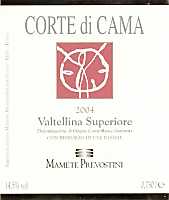
|
|
Valtellina Superiore Corte di Cama 2004 |
|
| Mamete Prevostini (Lombardy, Italy) | |
| Grapes: Nebbiolo | |
| Price: € 21.00 | Score: |
| Valtellina Superiore Corte di Cama shows a brilliant ruby red color and nuances of brick red, moderate transparency. The nose reveals intense, clean, pleasing, refined and elegant aromas which start with hints of cherry, plum and rose followed by aromas of strawberry, raspberry, violet, vanilla, tobacco, pink pepper, cinnamon and chocolate. The mouth has good correspondence to the nose, a tannic attack and pleasing crispness, however balanced by alcohol, full body, intense flavors. The finish is persistent with flavors of cherry, plum and strawberry. A well made wine. Valtellina Superiore Corte di Cama ages for 18 months in barrique. | |
| Food Match: Game, Roasted meat, Stewed and braised meat with mushrooms, Hard cheese | |

|
|
Sforzato di Valtellina Albareda 2004 |
|
| Mamete Prevostini (Lombardy, Italy) | |
| Grapes: Nebbiolo | |
| Price: € 30.00 | Score: |
| Sforzato di Valtellina Albareda shows a brilliant ruby red color and nuances of brick red, moderate transparency. The nose reveals intense, clean, pleasing, refined and elegant aromas which start with hints of cherry, violet and leather followed by aromas of rose, plum, raspberry, cinchona, vanilla, cocoa, tobacco, cinnamon, clover, mace and licorice. The mouth has excellent correspondence to the nose, a tannic attack and pleasing crispness, however balanced by alcohol, full body, intense flavors, pleasing roundness. The finish is very persistent with long flavors of cherry, plum and raspberry. A well made wine. Sforzato di Valtellina Albareda ages for 20 months in barrique followed by 12 months of aging in bottle. | |
| Food Match: Game, Roasted meat, Braised and stewed meat with mushrooms, Hard cheese | |

|
|
Sangiovese di Romagna Superiore Palpedrigo 2005 |
|
| Campodelsole (Emilia Romagna, Italy) | |
| Grapes: Sangiovese (90%), Merlot (10%) | |
| Price: € 12.50 | Score: |
| This wine shows an intense ruby red color and nuances of ruby red, moderate transparency. The nose denotes intense, clean, pleasing and refined aromas which start with hints of black cherry, plum and blackberry followed by aromas of blueberry, violet, vanilla, rose and carob. The mouth has good correspondence to the nose, a tannic attack and however balanced by alcohol, good body, intense flavors, pleasing crispness. The finish is persistent with flavors of black cherry and plum. Sangiovese di Romagna Superiore Palpedrigo ages for 12 months in barrique followed by 4 months of aging in bottle. | |
| Food Match: Roasted meat, Stewed meat with mushrooms, Hard cheese | |

|
|
Albana di Romagna Passito Font'Enea 2005 |
|
| Campodelsole (Emilia Romagna, Italy) | |
| Grapes: Albana | |
| Price: € 18.00 - 50cl | Score: |
| This wine shows an intense amber yellow color and nuances of amber yellow, transparent. The nose reveals intense, clean, pleasing and refined aromas which start with hints of dried fig, almond and honey followed by aromas of apricot jam, quince jam, date, candied fruits, walnut and vanilla. The mouth has good correspondence to the nose, a sweet attack and pleasing crispness, however balanced by alcohol, good body, intense flavors. The finish is persistent with flavors of dried fig, quince jam and almond. Albana di Romagna Passito Font'Enea ages for 6 months in barrique. | |
| Food Match: Confectionery, Fruit desserts | |
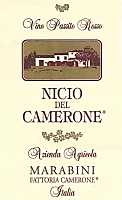
|
|
Nicio del Camerone |
|
| Fattoria Camerone (Emilia Romagna, Italy) | |
| Grapes: Sangiovese | |
| Price: € 18.00 - 50cl | Score: |
| Nicio del Camerone shows an intense ruby red color and nuances of brick red, moderate transparency. The nose reveals intense, clean, pleasing and refined aromas that start with hints of black cherry, blackberry and plum followed by aromas of tobacco, nail polish, vanilla, cinnamon and chocolate. The mouth has good correspondence to the nose, a sweet and slightly tannic attack, however balanced by alcohol, good body, intense flavors, pleasing crispness. The finish is persistent with flavors of plum, black cherry and blackberry. Nicio del Camerone ages in cask. | |
| Food Match: Fruit tarts | |

|
|
Sangiovese di Romagna Superiore Riserva Camerone Millennium 2003 |
|
| Fattoria Camerone (Emilia Romagna, Italy) | |
| Grapes: Sangiovese (85%), Cabernet Sauvignon (15%) | |
| Price: € 14.00 | Score: |
| This wine shows a brilliant ruby red color and nuances of garnet red, moderate transparency. The nose denotes intense, clean, pleasing and refined aromas that start with hints of cherry, plum and violet followed by aromas of raspberry, blueberry, vanilla, cinnamon, chocolate and rose. The mouth has good correspondence to the nose, a tannic attack and however balanced by alcohol, good body, intense flavors, pleasing roundness. The finish is persistent with flavors of cherry, plum and raspberry. Sangiovese di Romagna Superiore Riserva Camerone Millennium ages in barrique. | |
| Food Match: Roasted meat, Stewed meat, Broiled meat and barbecue, Hard cheese | |
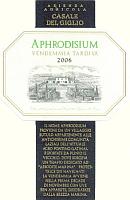
|
|
Aphrodisium 2006 |
|
| Casale del Giglio (Latium, Italy) | |
| Grapes: Viognier, Fiano, Greco Bianco, Petit Manseng | |
| Price: € 21.00 - 500ml | Score: |
| Aphrodisium shows a brilliant golden yellow color and nuances of golden yellow, very transparent. The nose reveals intense, clean, pleasing, refined and elegant aromas that start with hints of grape, peach and litchi followed by aromas of pineapple, banana, medlar, pear, quince, honey, almond and broom. The mouth has good correspondence to the nose, a sweet and round attack, however balanced by alcohol, good body, intense flavors, pleasing crispness. The finish is persistent with flavors of grape, peach and pineapple. A well made wine. Aphrodisium ferments in barrique. | |
| Food Match: Fruit desserts | |
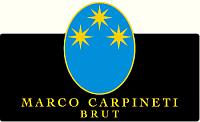
|
|
Brut |
|
| Marco Carpineti (Latium, Italy) | |
| Grapes: Bellone | |
| Price: € 8.00 | Score: |
| This sparkling wine shows a brilliant greenish yellow color and nuances of greenish yellow, very transparent, fine and persistent perlage. The nose denotes intense, clean and pleasing aromas which start with hints of apple, pear and orange followed by aromas of acacia, peach and pineapple. The mouth has good correspondence to the nose, an effervescent and crisp attack, however balanced by alcohol, light body, intense flavors. The finish is persistent with flavors of apple, pear and pineapple. This sparkling wine is produced with a long Charmat method. | |
| Food Match: Aperitifs, Crustacean appetizers, Dairy products, Risotto with vegetables | |
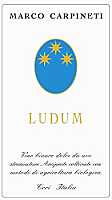
|
|
Ludum 2004 |
|
| Marco Carpineti (Latium, Italy) | |
| Grapes: Bellone | |
| Price: € 13.00 - 500ml | Score: |
| Ludum shows a brilliant amber yellow color and nuances of amber yellow, transparent. The nose denotes intense, clean, pleasing and refined aromas that start with hints of apricot jam and dried fig followed by aromas of peach jam, date, candied fruit, vanilla, nail polish, quince, honey and almond. The mouth has good correspondence to the nose, a sweet and round attack, however balanced by alcohol, good body, intense flavors, pleasing crispness. The finish is persistent with flavors of apricot jam, dried fig and date. Ludum ages for 12 months in cask. | |
| Food Match: Fruit jam tarts | |
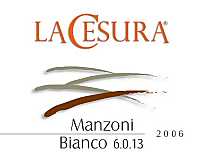
|
|
La Cesura Manzoni Bianco 6.0.13 2006 |
|
| Italo Cescon (Veneto, Italy) | |
| Grapes: Incrocio Manzoni 6.0.13 | |
| Price: € 9.90 | Score: |
| La Cesura Manzoni Bianco 6.0.13 shows an intense straw yellow color and nuances of greenish yellow, very transparent. The nose denotes intense, clean, pleasing and refined aromas that start with hints of peach, pear and pineapple followed by aromas of apple, plum, banana, hawthorn, tangerine and broom. The mouth has good correspondence to the nose, a crisp attack and however balanced by alcohol, good body, intense flavors, agreeable. The finish is persistent with flavors of peach, pineapple and pear. La Cesura Manzoni Bianco 6.0.13 ages for about 6 months in steel tanks. | |
| Food Match: Fried fish, Vegetable soups, Pasta and risotto with fish and crustaceans | |

|
|
Amaranto 72 Riserva 2004 |
|
| Italo Cescon (Veneto, Italy) | |
| Grapes: Cabernet Sauvignon (40%), Merlot (35%), Cabernet Franc (15%), Marzemino (10%) | |
| Price: € 19.90 | Score: |
| Amaranto 72 Riserva shows an intense ruby red color and nuances of ruby red, little transparency. The nose denotes intense, clean, pleasing and refined aromas that start with hints of plum, black cherry and black currant followed by aromas of violet, vanilla, tobacco, rhubarb, chocolate, eucalyptus and mace. The mouth has good correspondence to the nose, a tannic attack and however balanced by alcohol, full body, intense flavors. The finish is persistent with flavors of black cherry, black currant and plum. Amaranto 72 Riserva ages for 12 months in cask and for 12 months in barrique followed by 12 months of aging in bottle. | |
| Food Match: Game, Roasted meat, Braised and stewed meat, Hard cheese | |
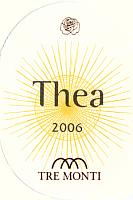
|
|
Colli di Imola Bianco Thea 2006 |
|
| Tre Monti (Emilia Romagna, Italy) | |
| Grapes: n.d. | |
| Price: € 18.00 | Score: |
| Colli di Imola Bianco Thea shows an intense golden yellow color and nuances of golden yellow, very transparent. The nose reveals intense, clean, pleasing and refined aromas that start with hints of apple, plum and jasmine followed by aromas of citrus fruits, hawthorn, almond, acacia, pear and honey. The mouth has good correspondence to the nose, a crisp attack and however balanced by alcohol, good body, intense flavors, pleasing roundness. The finish is persistent with flavors of apple, plum and almond. Colli di Imola Bianco Thea ages in steel tanks. | |
| Food Match: Pasta with meat, Roasted fish, Roasted white meat, Mushroom soups | |
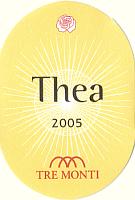
|
|
Sangiovese di Romagna Superiore Riserva Thea 2005 |
|
| Tre Monti (Emilia Romagna, Italy) | |
| Grapes: Sangiovese | |
| Price: € 18.00 | Score: |
| Sangiovese di Romagna Superiore Riserva Thea shows an intense ruby red color and nuances of garnet red, moderate transparency. The nose reveals intense, clean, pleasing, refined and elegant aromas that start with hints of black cherry, plum and violet followed by aromas of blackberry, blueberry, peony, vanilla, tobacco, pink pepper, juniper, cinnamon, chocolate, mace and menthol. The mouth has excellent correspondence to the nose, a tannic attack and pleasing roundness, however balanced by alcohol, good body, intense flavors, agreeable. The finish is very persistent with long flavors of black cherry, plum and blackberry. A well made wine. Sangiovese di Romagna Superiore Riserva Thea ages for 12 months in barrique. | |
| Food Match: Roasted meat, Stewed and braised meat with mushrooms, Hard cheese | |
|
||||||||
|
DiWineTaste Polls
|
| |||||||
Privacy Policy | |||||||


| Copyright © 2002-2024 Antonello Biancalana, DiWineTaste - All rights reserved |
| All rights reserved under international copyright conventions. No part of this publication and of this WEB site may be
reproduced or utilized in any form or by any means, electronic or mechanical, without permission in writing from DiWineTaste. |